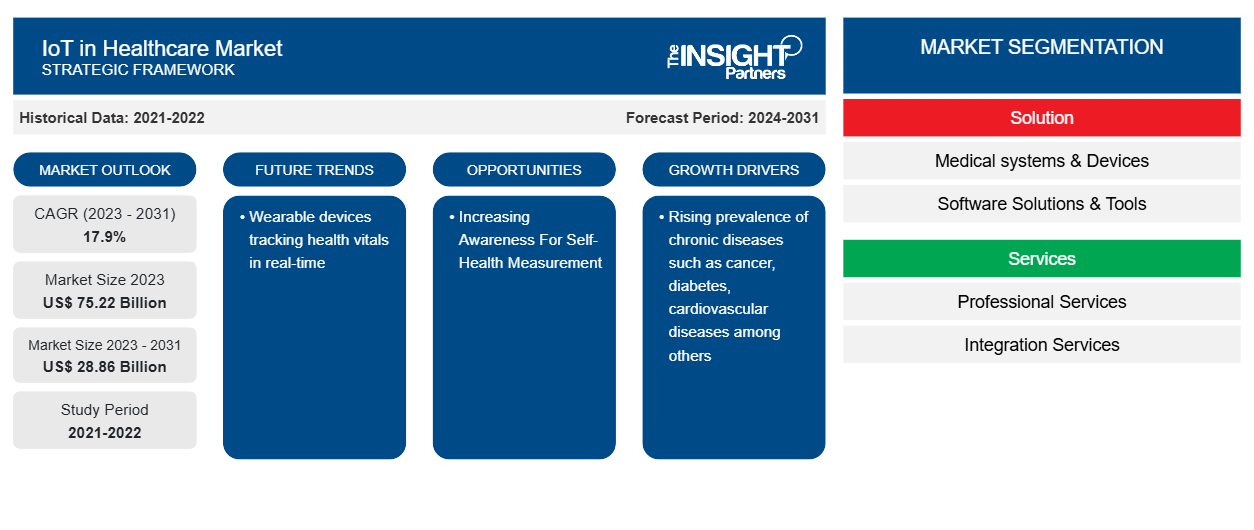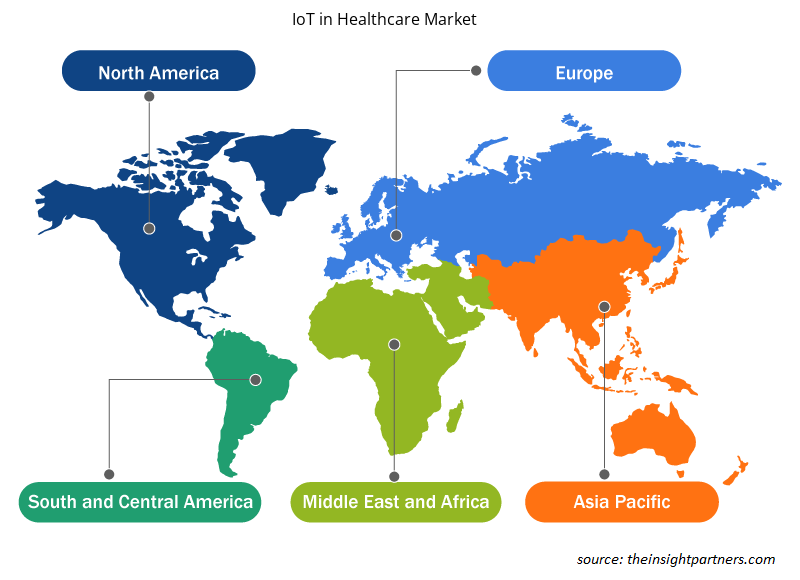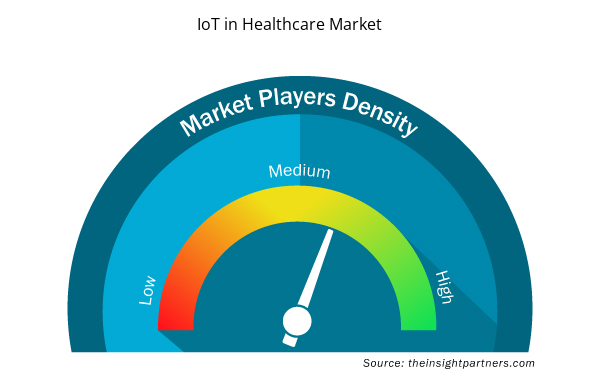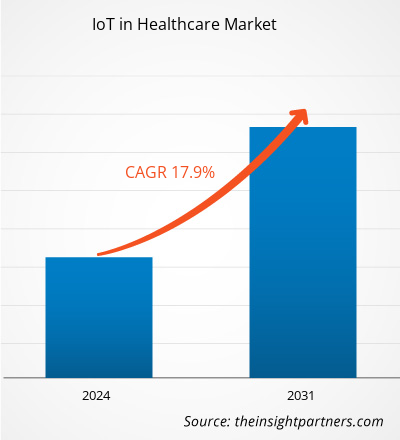The IoT in healthcare market size is projected to reach US$ 280.86 billion by 2031 from US$ 75.22 billion in 2023. The market is expected to register a CAGR of 17.90% during 2023 – 2031. Wearable devices tracking health vitals in real-time are likely to remain key trends in the market.
IoT in Healthcare Market Analysis
The increasing aging population is a key factor in increasing the demand for advanced and efficient healthcare solutions. IoT healthcare devices help in monitoring chronic conditions in the elderly population, thereby supporting independent living. According to United Nations Population Fund (UNFPA), in 2021, 153 million people were aged 60 and over, and is expected to reach 347 million by 2050, thus necessitating advanced healthcare infrastructure.
IoT in Healthcare Market Overview
The rising prevalence of chronic diseases such as cancer, cardiovascular diseases, diabetes, and others, rapid advancements in sensor technology, data analytics, connectivity, and benefits offered by IoT devices such as early detection of health conditions, minimizing hospital visits and admissions are key factors driving the growth of the market. However, the high cost associated with smart devices and IoT technology is likely to favor the market growth.
Customize This Report To Suit Your Requirement
You will get customization on any report - free of charge - including parts of this report, or country-level analysis, Excel Data pack, as well as avail great offers and discounts for start-ups & universities
IoT in Healthcare Market: Strategic Insights

- Get Top Key Market Trends of this report.This FREE sample will include data analysis, ranging from market trends to estimates and forecasts.
Customize This Report To Suit Your Requirement
You will get customization on any report - free of charge - including parts of this report, or country-level analysis, Excel Data pack, as well as avail great offers and discounts for start-ups & universities
IoT in Healthcare Market: Strategic Insights

- Get Top Key Market Trends of this report.This FREE sample will include data analysis, ranging from market trends to estimates and forecasts.
IoT in Healthcare Market Drivers and Opportunities
Rising Prevalence of Chronic Diseases to Favor Market
IoT technology has the potential to reduce the burden of chronic disease. IoT devices are either implanted or worn by the patient suffering from chronic disease and these devices are monitored over mobile and other wearable systems. As per the Global Cancer Observatory (GCO), in 2022, there were ~2,380,189 new cases of cancer in the US.
Increasing Awareness For Self-Health Measurement
The increasing awareness among people for the measurement of their self-health has propelled the demand for connected health devices. Nowadays wearable devices such as fitness bands, continuous glucose meters, and blood pressure monitors keep track of the patient’s activities throughout the day and store it in the connected smart device. The data stored in the connected device can be later used for analysis of the patient’s health. Also, another reason for the rise in awareness of self-health measurement is due to less cost required while using these devices in comparison to visiting a doctor for regular checkups. It is observed that these trends in self-health measurement have influenced the demand for IoT in healthcare devices and systems thus, providing a potential opportunity for IoT in the healthcare market.
IoT in Healthcare Market Report Segmentation Analysis
Key segments that contributed to the derivation of the XYZ market analysis are type, cause, disorder type, category, and end user.
- Based on solutions, the IOT in the healthcare market is categorized into medical systems & devices and software solutions & tools. Medical systems & devices held a larger market share in 2023 and are expected to continue their dominance during the forecast period
- By services, the market is bifurcated into professional services and integration services. The integration services segment held the largest share of the market in 2023.
IoT in Healthcare Market Share Analysis by Geography
The geographic scope of the IoT in healthcare market report is mainly divided into five regions: North America, Asia Pacific, Europe, Middle East & Africa, and South & Central America.
North America holds a significant market share in the global IoT healthcare market. Increasing adoption of remote patient monitoring, growing focus on chronic disease management, increasing elderly population, and government initiatives promoting IoT in healthcare are key factors driving the growth of the market during the forecast period. The National Institute of Standards and Technology, in 2022, initiated an IoT-Health program that focuses on the mathematical and computational modeling, optimization, visualization, performance evaluation, and experimentation of IoT-enabling technologies in healthcare. Similarly, in July 2023, the Biden-Harris Administration announced the development of the US Cyber Trust Mark, a cybersecurity labeling program for Internet of Things (IoT) devices to help consumers make informed purchases with security in mind. This trust mark could be applied to a variety of products, including Internet of Medical Things (IoMT) devices.
Asia Pacific is anticipated to grow with the highest CAGR in the coming years. Rising adoption of connected health devices, advancements in technology such as artificial intelligence and cloud-based solutions, and the growing prevalence of chronic diseases are likely to drive the growth of the market in the Asia Pacific region.
IoT in Healthcare Market Regional Insights
The regional trends and factors influencing the IoT in Healthcare Market throughout the forecast period have been thoroughly explained by the analysts at Insight Partners. This section also discusses IoT in Healthcare Market segments and geography across North America, Europe, Asia Pacific, Middle East and Africa, and South and Central America.

- Get the Regional Specific Data for IoT in Healthcare Market
IoT in Healthcare Market Report Scope
| Report Attribute | Details |
|---|---|
| Market size in 2023 | US$ 75.22 Billion |
| Market Size by 2031 | US$ 28.86 Billion |
| Global CAGR (2023 - 2031) | 17.9% |
| Historical Data | 2021-2022 |
| Forecast period | 2024-2031 |
| Segments Covered |
By Solution
|
| Regions and Countries Covered | North America
|
| Market leaders and key company profiles |
IoT in Healthcare Market Players Density: Understanding Its Impact on Business Dynamics
The IoT in Healthcare Market market is growing rapidly, driven by increasing end-user demand due to factors such as evolving consumer preferences, technological advancements, and greater awareness of the product's benefits. As demand rises, businesses are expanding their offerings, innovating to meet consumer needs, and capitalizing on emerging trends, which further fuels market growth.
Market players density refers to the distribution of firms or companies operating within a particular market or industry. It indicates how many competitors (market players) are present in a given market space relative to its size or total market value.
Major Companies operating in the IoT in Healthcare Market are:
- GE Healthcare
- IBM Corporation
- Koninklijke Philips N.V.
- Medtronic
- Microsoft Corporation
- Proteus Digital Health Inc.
Disclaimer: The companies listed above are not ranked in any particular order.

- Get the IoT in Healthcare Market top key players overview
IoT in Healthcare Market News and Recent Developments
The IOT in healthcare market is evaluated by gathering qualitative and quantitative data post primary and secondary research, which includes important corporate publications, association data, and databases. A few of the developments in the XYZ market are listed below:
- General Electric Company introduced a Wireless Patient Monitoring Solution - Portrait Mobile to Help Clinicians Detect Early Patient Deterioration. (Source: GE HealthCare, Press Release, June 2022)
- Accuhealth a leading provider of remote patient monitoring solutions, proudly announces the introduction of the world's first cellular-connected peak flow meter (PFM). This transformative technology aims to revolutionize at-home healthcare management for individuals living with chronic obstructive pulmonary disease (COPD). (Source: ccuhealth Technologies LLC, Press Release, August 2023)
IoT in Healthcare Market Report Coverage and Deliverables
The “IoT in Healthcare Market Size and Forecast (2021–2031)” report provides a detailed analysis of the market covering below areas:
- IOT in healthcare market size and forecast at global, regional, and country levels for all the key market segments covered under the scope
- IOT in healthcare market trends as well as market dynamics such as drivers, restraints, and key opportunities
- Detailed PEST/Porter’s Five Forces and SWOT analysis
- IOT in healthcare market analysis covering key market trends, global and regional framework, major players, regulations, and recent market developments
- Industry landscape and competition analysis covering market concentration, heat map analysis, prominent players, and recent developments for the IOT in healthcare market
- Detailed company profiles
- Historical Analysis (2 Years), Base Year, Forecast (7 Years) with CAGR
- PEST and SWOT Analysis
- Market Size Value / Volume - Global, Regional, Country
- Industry and Competitive Landscape
- Excel Dataset



Report Coverage
Revenue forecast, Company Analysis, Industry landscape, Growth factors, and Trends

Segment Covered
Solution , Services Application and End-user

Regional Scope
North America, Europe, Asia Pacific, Middle East & Africa, South & Central America

Country Scope
US, Canada, Mexico, UK, Germany, Spain, Italy, France, India, China, Japan, South Korea, Australia, UAE, Saudi Arabia, South Africa, Brazil, Argentina
Frequently Asked Questions
North America dominated the IOT in the healthcare market in 2023
Rising prevalence of chronic diseases such as cancer, cardiovascular diseases, diabetes, and others, rapid advancements in sensor technology, data analytics, connectivity, and benefits offered by IoT devices such as early detection of health conditions, minimizing hospital visits and admissions are key factors driving the growth of the market
Wearable devices tracking health vitals in real-time are likely to remain key trends in the market.
GE Healthcare, IBM Corporation, Koninklijke Philips N.V., Medtronic, Microsoft Corporation, Proteus Digital Health Inc., Qualcomm Life Inc., Siemens Healthcare Gmbh, Stanley Healthcare, Verily Life Sciences LLC among others
The IOT in healthcare market size is projected to reach US$ 280.86 billion by 2031.
The market is expected to register a CAGR of 17.90% during 2023 – 2031.

 Get Free Sample For
Get Free Sample For